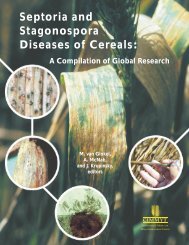Section 3 (Crop Management)
Section 3 (Crop Management)
Section 3 (Crop Management)
You also want an ePaper? Increase the reach of your titles
YUMPU automatically turns print PDFs into web optimized ePapers that Google loves.
Maize-rice rotation in Thailand<br />
From the results, it can be recommended that maize should be grown under uniformity area and welldrained<br />
soils namely loam, sandy loam and clay loam. The planting time of maize in post-rice condition<br />
varies from year to year depending on the time of rice harvesting, however from November to December<br />
is found the best. After harvesting rice, the conventional tillage should be practiced and fertilized with 50-<br />
62.5–0 of N-P2O5-K2O kg ha -1 . Single cross hybrids are planted with 0.75 X 0.20 meter spacing with 1<br />
plant hill -1 (66,666 plants ha -1 ). Three weeks after planting, urea at 156 kg/ha is applied and then hilling<br />
up the plants. Furrow method throughout the growing season, which is depended on the soil and weather<br />
conditions.<br />
To increase maize productivity in paddy field, there is a need to plan the cropping systems pattern<br />
including good agricultural practices. It should be also cooperate among maize growers to manage the<br />
marketing and production inputs in order to increase gross return and reduce production costs. Moreover,<br />
the cooperation between the maize grower and the public section and the private section is needed to<br />
increase maize production in this area.<br />
Future work<br />
1. Improvement of maize genotypes for post-rice condition should be done if productivity of maize<br />
grown after rice is to be improved.<br />
2. High production costs particularly labors and inputs for maize grown after rice could be solved if<br />
the rice-maize system is further continued.<br />
3. On-farm trial of package for maize production should be further done at the given areas.<br />
Literature Cited<br />
Benchaphan Ekasingh,; Kuson Thong-Ngam,; and Phrek Gypmantasiri. (2001). Farmers’ production<br />
practices, yields and profitability in major maize growing areas of Thailand, 1998-1999. AGS<br />
Working Paper No. 142. MCC, Faculty of Agriculture. 28 pp.<br />
Boonpradub, S.; Chatairi, M. and Senanarong, N. (1998). Maize cultivation in paddy field research in<br />
Thailand. P. 399-406. In S.K. Vasal et al. (eds.) Proceedings of The Seventh Asian Regional Maize<br />
Workshop. PCARRD, Los Banos, Philippines.<br />
Boonpradub, S. and Welsh, T. (1999). No-till irrigated corn production in Thailand. P. 719-720. In The<br />
17 th Asian-Pacific Weed Science Society Conference, Bangkok, Thailand.<br />
Boonpradub, S. and Senthong, C. (2001). Drought response of maize genotypes under an irrigation<br />
gradient. Thai J. Agric. Sci. 34(3-4) : 217-228.<br />
CIMMYT. (1988). From agronomic data to farmer recommendations : An Economic Training Manual.<br />
CIMMYT. 79 p.<br />
Giradin, P.; Tollenaar, M.; Deltour, A. and J. Muldoon. (1987). Temporary N starvation in maize (Zea<br />
may L.) : effects on development, dry matter accumulation and grain yield. Agronomic. 7: 289-296.<br />
Gassity P.D. and Hermenegildo, C.G. (1990). The development of rice-corn rotations in tropical lowland<br />
environments: A systems research approach. Food and Fertilizer Technology Center. Taipei City,<br />
Rep. of China on Taiwan. Extension Bulletin No.318. 10 pp.<br />
Granados,G.; Kitbamroong, C.; Tavarasook, C.; Chatasiri, M.; Grudloyma, P.; Chotichun, S. and<br />
Boonpradab, S. (1994). Winter maize in paddy fields research conducted in Thailand in 1992-1994. A<br />
progress Report. 26 p.<br />
Gomez, A.A. and Gomez, K.A. (1983). Multiple cropping in the humid tropicals of Asia. Ottawa, Ont.,<br />
IDRC. 248 pp.<br />
- 311 -









